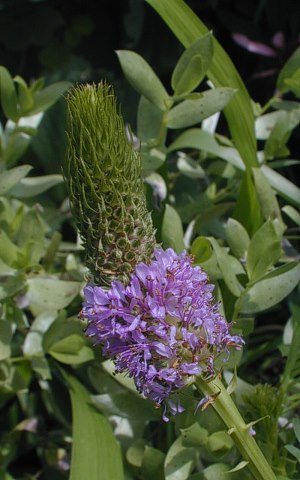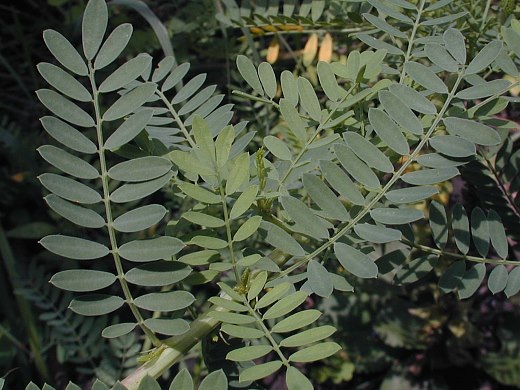Description:
This
perennial wildflower is about 1-2' tall, branching occasionally
to frequently. It is ascending to erect, although some of the side
branches may sprawl across the ground in open areas. The central stem
and side branches are light green, hairless, and terete or angular in
cross-section. The alternate compound leaves are odd-pinnate with 5-15
pairs of leaflets and a terminal leaflet; the compound leaves are up to
3" long and they have short petioles. Individual leaflets are 3/8" long
and 1/8" across; they are medium green, oblong, hairless, and smooth
along their margins. Each leaflet has a very short petiole and a tiny
pointed tip. Upper stems terminate in individual spikes of flowers that
are short and cylindrical in shape; individual flowers and their bracts
are densely crowded together along the length of each spike in all
directions. The petals of
these flowers are medium purple or rose-pink (rarely white), while
their sepals and bracts are green-white. Each flower has 5 petals, 5
sepals, 5 stamens, and a pistil with a single style. The petals are
oblanceolate or obovate and longer than the sepals. The short sepals
are lanceolate with green tips and white bases. Underneath each flower,
there is a lanceolate bract with an elongated tip that is awn-like. The
exerted stamens have white or pale purple filaments and orange to brown
stamens. The blooming period occurs from mid- to late summer and lasts
about 1-2 months. There is no noticeable floral scent. Each flower is
replaced by a short seedpod with a slender beak that is largely
enclosed by the persistent sepals; each seedpod contains 1-2 smooth
seeds. As the seeds mature, the floral spikes become dark brown. The
root system consists of a short stout taproot with fibrous rootlets.
This wildflower reproduces by reseeding itself. Individual plants
typically live less than 8 years.
petiole and a tiny
pointed tip. Upper stems terminate in individual spikes of flowers that
are short and cylindrical in shape; individual flowers and their bracts
are densely crowded together along the length of each spike in all
directions. The petals of
these flowers are medium purple or rose-pink (rarely white), while
their sepals and bracts are green-white. Each flower has 5 petals, 5
sepals, 5 stamens, and a pistil with a single style. The petals are
oblanceolate or obovate and longer than the sepals. The short sepals
are lanceolate with green tips and white bases. Underneath each flower,
there is a lanceolate bract with an elongated tip that is awn-like. The
exerted stamens have white or pale purple filaments and orange to brown
stamens. The blooming period occurs from mid- to late summer and lasts
about 1-2 months. There is no noticeable floral scent. Each flower is
replaced by a short seedpod with a slender beak that is largely
enclosed by the persistent sepals; each seedpod contains 1-2 smooth
seeds. As the seeds mature, the floral spikes become dark brown. The
root system consists of a short stout taproot with fibrous rootlets.
This wildflower reproduces by reseeding itself. Individual plants
typically live less than 8 years.
Cultivation:
The preference is full or partial sunlight (at least one-half day of
sunlight), moist to slightly dry conditions, and a thin rocky soil. The
pH of the soil should lie within the range 6.0–8.0; strongly acidic
soil should be avoided. This wildflower will adapt to ordinary
clay-loam garden soil if its location is sunny and well-drained;
however, it is intolerant of competition from taller and more
aggressive plants.
Range & Habitat:
Leafy Prairie Clover has been observed in only a few counties in
northern Illinois (see Distribution
Map). Today, it is restricted to 2-3 small colonies in Will
County; the populations of the remaining colonies have been extirpated
by development or over-collection. Leafy Prairie Clover also occurs in
Tennessee and Alabama. Populations have declined in all three states.
This native plant is quite rare and it is listed as 'endangered' by
both
the state of Illinois and the Federal government. In Illinois, habitats
are restricted to mesic dolomite prairies and rocky riverbanks. In
Tennessee and Alabama, habitats are restricted to cedar glades and
meadows along the edges of cedar glades.
Faunal Associations:
Floral visitors of Leafy Prairie Clover are probably similar to the
floral visitors of Dalea purpurea (Purple Prairie
Clover); the insect visitors of the latter include many kinds of bees
(short-tongued & long-tongued), butterflies, flies, and
occasional wasps. These insects are attracted to the nectar and/or
pollen of the flowers. The caterpillars of the butterfly Colias
cesonia (Dogface Sulfur) feeds on the foliage of Dalea
spp. (Prairie Clovers) and other species in the Bean family.
Other insects that feed on Prairie Clovers include Apion
amaurum (Weevil sp.), Apion capitone
(Weevil sp.), and Pachybrachis othonus (Cylindrical
Leaf Beetle sp.); none of these records are specific to Leafy Prairie
Clover, however. The foliage of Leafy Prairie Clover is highly
palatable to mammalian herbivores, including deer, rabbits, groundhogs,
cattle, horses, and others. In Illinois, rabbits have been a major
cause of plant mortality for this species. This rare wildflower should
be protected from such animals where their populations are excessive.

Photographic
Location:
The wildflower garden of the webmaster in Urbana, Illinois; the
photographed plant was obtained from a specialist nursery using
horticultural sources, rather than wild-collected material.
Comments:
Unfortunately, this attractive wildflower is approaching extinction in
natural areas. Compared to other Dalea spp.
(Prairie Clovers), it has a more leafy appearance. Leafy Prairie Clover
can be distinguished from other Prairie Clovers in Illinois by the
number of leaflets per compound leaf (typically 21-25, although there
can be fewer or more leaflets than this). Both Dalea purpurea
(Purple Prairie Clover) and Dalea candida (White
Prairie Clover) have fewer leaflets per compound leaf (less than 10).
As it common name suggests, White Prairie Clover has flowers with white
petals. The floral bracts of Purple Prairie Clover are shorter than
those of Leafy Prairie as they lack the awn-like tips of the latter. A
species that is found in neighboring states (although not Illinois), Dalea
villosa (Silky Prairie Clover) has abundant leaflets, but its
foliage is covered with abundant silky hairs. In contrast, Leafy
Prairie Clover has hairless foliage.